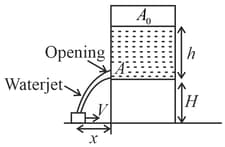What is the use of a filter pump ? How does it work ?
Important Questions on Mechanical Properties of Fluids
What will be the nature of flow of water from a circular tap, when its flow rate increased from to The radius of the tap and viscosity of water are and , respectively. (Density of water : )
Consider the configuration of a stationary water tank of cross-section area and a small bucket as shown in figure below;

What should be the speed of the bucket, so that the water leaking out of a hole of cross-section area (as shown) from the water tank does not fall outside the bucket?
(Take, and ).
What is velocity profile? Draw the velocity profiles for a liquid flowing over a horizontal solid surface.
.
Consider the following statements:
1. Taking into account, the fact that any object which floats must have an average density less than that of water during World War 1, a number of cargo vessels were made of concrete.
2. Concrete cargo vessels were filled with air.
3. A ship floats higher in the water on a high-pressure day than on a low-pressure day.
4. Floating of the ship in the water is not possible because of the buoyancy force which is present due to pressure difference.
Which of the statements given above are correct?

